It is overland tour to Mt. Wudangshan in Hubei province from Xian. Hubei province is located in mid China connecting many provinces in China by convenient transportation of railway, cruise, and flights......
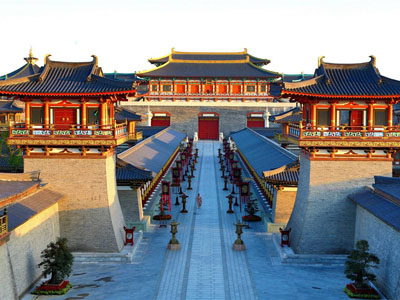
Mount Emeishan is one of the Top Four famous Buddisham mountains in China, and it is also a world cultural and natural heritage. Mt. Emeishan is located in the southwest of Emei City, Sichuan Province. It is said that Mount Emei is the ashram of Puxian Bodhisattva. Buddhism believes that Bodhisattva Bodhisattva is a symbol of virtue. Mt. Emeishan has more than 100 temples, after several rise and downs, the existing main temples are Wannian Temple, Baoguo Temple, Fuhu Temple and so on.
Mt. Emeishan is a branch of the Qionglai Mountain series, rising from the Emei Plain. The mountain extends from north to south, stretching for 23 kilometers, covering an area of about 110 square kilometers. The main peaks of Mt Emeishan are Tai'an, Er’e san, San e san and Si e san, among which the highest point is altitude of 3,099 meters.
Emeishan Climate
Mt. Emeishan is located in the subtropical monsoon climate region, the whole mountain area is rich in clouds and abundant rainfall, and less sunshine. The relative height difference between the top of Mt. Emeishan mountain and Emei city is more than 2600 meters, with a temperature difference of 14.0℃. The annual average temperature in Emei city is 17.2℃; when the height rises to the top of 3000 m, the temperature is only 3.0℃.
Emeishan Plant Resources
Mt. Emeishan has 242 families of higher plants with more than 3200 species. The plant category of Mount Emeishan accounts for about one-tenth of the total number of plant species in China. There are more than 320 species endemic to Mount Emeishan or China, accounting for 10% of the total number of plants in the mountain, higher than that of the whole of China. More than 100 species of plants were first found in Mount Emei shan and named as "Emei". Mt. Emeishan has a complete range of plants, especially in the medicinal, ornamental, edible and other aspects of the most abundant and diverse resource plants.
Emeishan Animal Resources
There are more than 2,300 known animal species in Mount Emeishan, including 51 species of animals, 256 species of birds, 34 species of reptiles, 33 species of amphibians, more than 1,000 species of insects and 60 species of fish. In addition, there are also 157 rare specialties such as red panda, forest musk deer, musk deer, short tail monkey, antelope, silver pheasant, pheasant, bearded frog, playing frog and ancient butterfly, as well as the model of Mount Emeishan.
Mt. Emeishan Culture
Mount Emeishan has a profound cultural heritage and is a sacred place of Buddhism in China, known as the "Buddha paradise". Mount Emei has been listed in the World Cultural and Natural Heritage List by UNESCO for its natural landscape of "Great, Green, God, Strange and spirit" and profound Buddhist culture. The scenic area covers an area of about 154 square kilometers, and the highest peak is 3,099 meters above sea level. There are about 26 temples.
Mount Emeishan Attractions:
Jinding Golden Summit
The Jinding, means golden summit, is the symbol of Mount Emeishan, and the Golden Buddha is the symbol of Mount Emeishan. People think they have not been to Emeishan if not visit Jinding Golden Summit, not been to Jingding if not worship gold Buddha, which will be a regret of lifetime. Jinding Golden Summit is the collection of Mount Emeishan attractions and temples, the harmonious coexistence between man and nature, and the integration of Puxian Buddha’s wishes and people's good wishes. The 48 meters high statue of Puxian Buddha stands on the golden roof, gathering the aura of heaven and earth, reflecting the brilliance of the sun and the moon, overlooking the world, round the wishes of all living beings. The elegant and beautiful Bodhisattva Puxian sits upright on the platform of the white elephant and the lotus flower, with his expression fixed, compassionate and peaceful. The clouds float around the Buddha. When the rays of the sun shines on the top of the Buddha  statue, countless auspicious light reflected from the golden Buddha, for the sea of clouds inlaid with a magnificent gold edge. This spectacle shocked the hearts of all living beings, making good men and women, all kneel down to look up and worship. In the face of the golden Buddha, practicing their heart, getting their fortune, completing their all the wishes.
statue, countless auspicious light reflected from the golden Buddha, for the sea of clouds inlaid with a magnificent gold edge. This spectacle shocked the hearts of all living beings, making good men and women, all kneel down to look up and worship. In the face of the golden Buddha, practicing their heart, getting their fortune, completing their all the wishes.
Wannian Temple
Wannian Temple in Mt. Emeishan began to be built by the monk Huichi in Jin Dynastery (399 AD.). At first, it was named as Puxian Temple. In the twenty-ninth year of Wanli of the Ming Dynasty (1601), the Emperor Shenzong congratulated the empress dowager on her 70th birthday and gave the temple the name Wannian temple, means holy Longevity Temple.
Baoguo Temple
Baoguo Temple is the first temple on the way of Mount Emeishan, at the foot of the mountain. It was first built in the Wanli Period of the Ming Dynasty (1573- -1619 AD.). Emperor Kangxi of the Qing Dynasty took the name of Baoguo from inscription of "Four Benefits and Four Paying Back ", and the temple has been preserved after several times.
Fuhu Temple
Fuhu Temple, means Tiger Dpressing Temple, located at the foot of Mount Emeishan, is a nun temple. According to the book of Mount Emeishan, it was built by a monk Xin An in the Jin Dynasty. Because the temple is in the shape of the crouching tiger, it is namedFuhu Temple.
QingYin pavilion
Qingyin Pavilion is one of the eight key temples in Mount Emei. It was built by the Zen master Huitong monk during the reign of Tang Xizong emperor for the statues of Master Sakyamuni, Manjusri and Puxian. This pavilion is built on the ridge between Black Dragon River and White Dragon River, and the situation is steep. Surrounded by lush forests, green color. With Qingyin Pavilion as the center, Qingyin Pavilion, Niuxin Temple, Guangfu Temple, Bailong Temple and Baiyun Gorge constitute the Buddhist temple garden environment with natural landscape as the main theme, which is a huge and rare wild Buddhist temple garden in the world. In the Qingyin Pavilion, tourists can see the color of the mountains and water, smell the fragrance of flowers and plants, hear the clear sound of the stream spring, and touch the pavilions and steles. It concentrates the visual beauty, hearing beauty, smell beauty, so that visitors get the overall aesthetic feeling of Emei scenery. Ancient and modern visitors are often known as "Mount Emei first scenery".
Xixiangchi Washing Elephant Pool Temple
The Xixiangchi Washing Elephant Pond Temple is one of the eight temples in Mount Emeishan. Xixiangchi is located on 2070 meters above sea level in Mount Emeishan. The small pool in front of the temple was converted into six squares by the monks, and a stone elephant was placed on the side of the pool to follow the legend of the Bodhisattva Bodhisattva washing the elephant. Legend has it that when the Bodhisattva passed by, the white elephant once bathed in the pool, so it was renamed the elephant washing pool. The temple pool is rich in cultural relics. On the sutras building, there is an exquisite porcelain statue of Avalokitesvara Bodhisattva, which is well made. At the same time, the Xixiangchi Elephant Washing pool temple also has other precious cultural relics. The scenery around the Xixiangchi temple is very beautiful. Ffir around the temple, "elephant pond night moon" is one of the ancient ten scenes of Mount Emeishan: whenever there is no cloud weather, the sky is blue and the moon in the sky is clear. Moonlight through the fir forest, reflected into the pool, the water and sky color, as if out of the clouds, let the spirit is very happy. There are often monkeys in this area, and the monks treat them with compassion. People and animals live in harmony with each other.
Xianfeng Temple
Xianfeng Temple is one of the eight temples of Mount Emeishan, located under the Xianfeng Rock, 1725 meters above sea level. The temple was founded in the Yuan Dynasty (1281 AD). The temple has a special storage of the emperor of the Tripittra building. There are many trees growing around Xianfeng Temple, with white flowers of pigeons-winging-shaped. When the breeze blows, the flowers dance, are the world's rare plants, westerners call "Chinese pigeon tree".
Jieyingdian Receive the hall
Jieying means Receive. The hall is located in Mount Mountain, 2540 meters above sea level. The temple has a copper iron arhat hall. The hall is brilliant, Buddha is solemn and noble. The painted arhat on the wall of the niche is painted by the Zhuchan masters, and the art and technology are very exquisite. Outside the temple vision is broad, can see the sea of clouds and Buddha light, magnificent scenery. Because the geographical location of the temple in the scenic area, fir trees, towering into the cloud.During the period of the Republic of China, the famous Chinese painter Zhang Daqian stayed here mostly daily and created many excellent works.
Monkey area
Mount Emeishan ecological monkey area is located in Qingyin Pavilion of Emeishan, a line to Hongchunping. Monkey area is a long and narrow valley, covering an area of 25 hectares, is the largest natural ecological monkey reserve in China. There are more than 300 three family wild monkeys in the ecological monkey area. The spirit monkey in Emeishan is the spirit of Mount Emei, they are playful, charming and extremely human nature. They are not surprised when meeting with people, play with people with joy and bring countless joy to visitors, become a living landscape of Mount Emei. Playing with the monkeys, feeding the monkeys, watching its various shapes, understanding its ecological habits, and finally having a close touch, has become an indispensable project for tourists to visit Mount Emeishan.
Giant Buddha Zen Temple
The Dafo Chanyuan, also named Giant Buddha Zen Temple in Emeishan is the most magnificent Han and Chinese Buddhist temple in Asia. Zen covers an area of more than 400 mu, construction area of 56,000 square meters, is the first gateway to worship Mount Emeishan. The Giant Buddha Temple stands towering in the south of Emeishan city. With the temple as the core, the Buddhist cultural tourism scenic spot integrates religious worship, tourism, ecological experience and urban leisure. Dafo Giant Buddha Temple is a relatively complete functional system. It has realized the compatibility of a variety of functions of pure meditation, education, promotion the Buddhism. The Giant Buddha Temple has become an important platform for Mount Emeishan to promote Buddhism, cultivate monks, study Buddhism, exchange with foreign countries, and protect, display and publicize cultural relics. The Giant Buddha Temple sits west to east, the overall layout is divided into three functional areas: the north (near the urban area) is the Buddhist worship area, namely the religious ceremony space, the central part is the Buddhist garden culture sharing area, and the south is the education area of Buddhist colleges, namely Sichuan Buddhist College.
The main building sit west to east, 11 into the courtyard, along the central axis, in turn by the arch, the bright street, the gate, the peacock Ming temple, the Maitreya hall, master hall, giant screen wall, bright mountain, sit 11 level platform, before and after the height difference of 33 meters, according to the terrain step by step, majestic.
Emei Shan Mountain Tour Map:
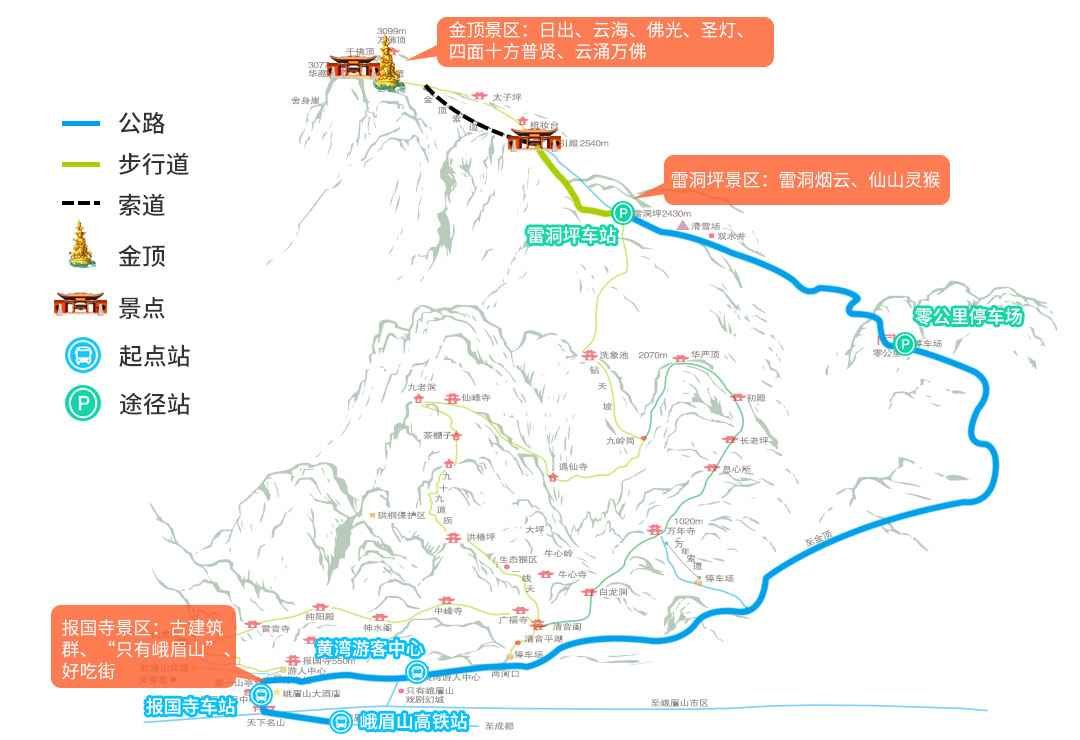
Weather Information of Emei Shan Mountain:
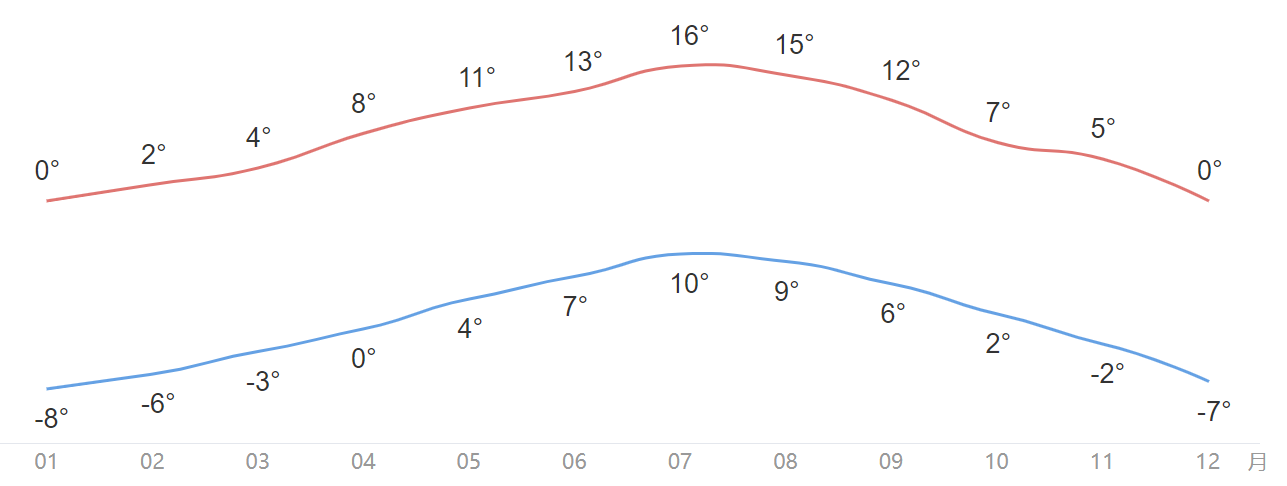
Note: From January to December, red line is the highest Centigrade in average, blue line is the lowest climate in average.
Recommended Emei shan Tours Packages:
1. 2 Days Mt. Emeishan and Leshan Bullet Train Adventure
2. 3 Days Chengdu Emeishan and Leshan Giant Buddha Tour
3. 3 Days Mt. Emeishan Hiking Tour
4. 2 Days Leshan Giant Buddha,Luocheng Ancient Town and Emei Mountain Tour from Chegndu
5. 8 Days Classic Tour of Jiuzhaigou,Leshan and Chengdu
6. 8 Days Sichuan classical Tour

It is overland tour to Mt. Wudangshan in Hubei province from Xian. Hubei province is located in mid China connecting many provinces in China by convenient transportation of railway, cruise, and flights......
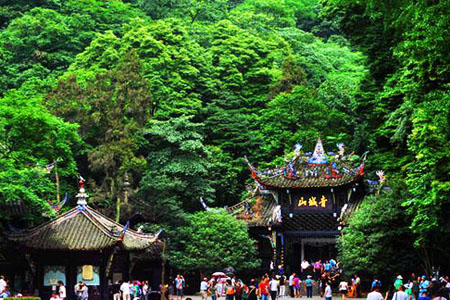
One day classic tours of Chengdu to Mt. Qingchengshan and Dujiangyan Dam will show tourist the profound of ancient Chinese wisdom and culture in harmony relation with the world. ......
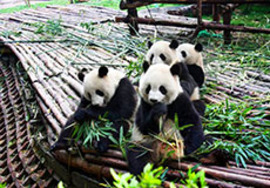
The most classic one day Chengdu tours will bring tourist to Chengdu Giant panda garden and Leshan giant buddha with private travel guide and car in Chengdu, extremely convenient and easy!......

One days best Chengdu tours bring tourist to Sanxingdui museum and giant panda garden with private guide and car, making your tour in Chengdu easy. ......
This panda volunteer work provide tourist with one days unique experience of Panda volunteer project works and bring them an intimate touch with Giant pandas, also the best way to learn deep about pand......
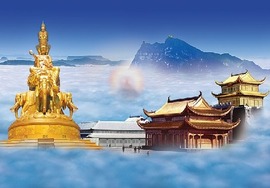
It is tour from the only one operator in Chengdu tours market offering Emeishan and Leshan tours by bullet train. Our highlights including Leshan Giant Buddha and Mt Emeishan. ......

